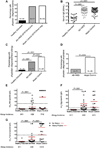Diminished allergic disease in patients with STAT3 mutations reveals a role for STAT3 signaling in mast cell degranulation
- PMID: 24184145
- PMCID: PMC3881191
- DOI: 10.1016/j.jaci.2013.08.045
Diminished allergic disease in patients with STAT3 mutations reveals a role for STAT3 signaling in mast cell degranulation
Erratum in
- J Allergy Clin Immunol. 2014 Apr;133(4):1232. Nelson, Celeste G [added]
Abstract
Background: Severe atopic conditions associated with elevated serum IgE are heterogeneous with few known causes. Nearly every patient with autosomal-dominant hyper-IgE syndrome (AD-HIES) due to signal transducer and activator of transcription 3 (STAT3) mutations has a history of eczematous dermatitis and elevated IgE; however, clinical atopy has never been systematically studied.
Objective: Understanding of genetic determinants of allergic disease may lead to novel therapies in controlling allergic disease.
Methods: We conducted clinical evaluation of the rates of food allergies and anaphylaxis in patients with AD-HIES, a cohort of patients with no STAT3 mutation but with similar histories of elevated IgE and atopic dermatitis, and healthy volunteers with no history of atopy. Morphine skin prick testing, ImmunoCAP assays for allergen-specific IgE, and basophil activation were measured. A model of systemic anaphylaxis was studied in transgenic mice carrying an AD-HIES mutation. STAT3 was silenced in LAD2 and primary human mast cells to study the role of STAT3 in signaling and degranulation after IgE cross-linking.
Results: Food allergies and anaphylaxis were markedly diminished in patients with AD-HIES compared with a cohort of patients with no STAT3 mutation but with similar histories of elevated IgE and atopic dermatitis. Morphine skin prick testing and basophil activation were diminished in patients with AD-HIES, whereas mice carrying an AD-HIES mutation were hyporesponsive to systemic anaphylaxis models. Rapid mast cell STAT3 serine727 phosphorylation was noted after IgE cross-linking, and inhibition of STAT3 signaling in mast cells lead to impaired FcεRI-mediated proximal and distal signaling, as well as reduced degranulation.
Conclusion: This study serves as an example for how mutations in specific atopic pathways can lead to discrete allergic phenotypes, encompassing increased risk of some phenotypes but a relative protection from others.
Keywords: 2,4-Dinitrophenol; AD-HIES; Autosomal dominant hyper-IgE syndrome; BSB; Basophile stimulation buffer; DNP; ERK; Extracellular signal-regulated kinase; Job syndrome; NIH; National Institutes of Health; PE; Phycoerythrin; STAT3; Short hairpin RNA; Signal transducer and activator of transcription 3; degranulation; mast cell; shRNA; signal transducer and activator of transcription 3.
Published by Mosby, Inc.
Conflict of interest statement
Disclosure of potential conflict of interest: N. Jones has been supported by one or more grants from SAIC. M. O’Brien owns stock/stock options in PFE. J. Rivera is a member of the University of Singapore Scientific Advisory Board, is chair of the INFLAMEX LABEX Center of Excellence-INSERM SAB, and has one or more patents (planned, pending, or issued) with the National Institutes of Health. A. M. Siegel has been supported by one or more grants from the National Institute of Allergy and Infectious Diseases (Intramural Funding) and is employed by and owns stock/stock options in Amplimmune, Inc. The rest of the authors declare that they have no relevant conflicts of interest.
Figures




References
-
- Holland SM, DeLeo FR, Elloumi HZ, Hsu AP, Uzel G, Brodsky N, et al. STAT3 mutations in the hyper-IgE syndrome. N Engl J Med. 2007;357:1608–1619. - PubMed
-
- Minegishi Y, Saito M, Tsuchiya S, Tsuge I, Takada H, Hara T, et al. Dominant-negative mutations in the DNA-binding domain of STAT3 cause hyper-IgE syndrome. Nature. 2007;448:1058–1062. - PubMed
-
- Buckley RH, Wray BB, Belmaker EZ. Extreme hyperimmunoglobulinemia E and undue susceptibility to infection. Pediatrics. 1972;49:59–70. - PubMed
-
- Eigenmann PA, Sicherer SH, Borkowski TA, Cohen BA, Sampson HA. Prevalence of IgE-mediated food allergy among children with atopic dermatitis. Pediatrics. 1998;101:E8. - PubMed
Publication types
MeSH terms
Substances
Grants and funding
LinkOut - more resources
Full Text Sources
Other Literature Sources
Medical
Miscellaneous

